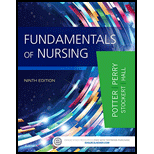
Concept explainers
(a)
To explain:
How are going to use caring practices to help Mrs. L’s crying knowing that your day has just started and you have many nursing interventions yet to complete?
Case summary:
Mrs. L is a 52-year-old patient is being treated for lymphoma. She is discouraged about the current status of her health. She had a lot of muscle pain. She is receiving care in a unit with more number of sick patients and limited staffs.
(a)
Explanation of Solution
The nurse should get on to the side of Mrs. L and touch her shoulder which is an example of caring touch. This is a comforting approach to the patients who are facing frightening, painful, and embarrassing situations. The nurse should listen to the patient in order to understand the reason for her crying. Though, the nurse having much more work yet to be completed, has to spend some time to the patient’s difficulty.
(b)
To explain:
Mrs. L explains that her pain is very bothersome and worse when she was alone. Mrs. L and the nurse determined that an injection would be beneficial for her pain. In what way, you show caring to Mrs. L in the way you administer the injection for her muscle pain?
Case summary:
Mrs. L is a 52-year-old patient is being treated for lymphoma. She is discouraged about the current status of her health. She had a lot of muscle pain. She is receiving care in a unit with more number of sick patients and limited staffs.
(b)
Explanation of Solution
The nurse has to proceed with the medical measures that help to relieve the patient from the pain. The nurse must follow a task-oriented caring procedure. This method of caring is used to seek consideration from the patient’s concern. While administering the injection, the nurse should talk with the patient quietly in order to provide support and reassurance.
(c)
To explain:
Mrs. L seems to get better and comfortable and was crying less. You find out that your day is more controlled. What else can you do for Mrs. L?
Case summary:
Mrs. L is a 52-year-old patient is being treated for lymphoma. She is discouraged about the current status of her health. She had a lot of muscle pain. She is receiving care in a unit with more number of sick patients and limited staffs.
(c)
Explanation of Solution
The nurse should comfort the patient and should help to maintain the beliefs in order to get through the transition or event and to face the upcoming situations or future with a meaning. The nurse should motivate the patient to maintain a hope-filled attitude during her illness. The nurse could also provide spiritual caring according to the patient’s beliefs. Providing family support will also help to make her physically and emotionally comfortable.
Want to see more full solutions like this?
Chapter 7 Solutions
Fundamentals of Nursing, 9e
- explain an abdominal exam?arrow_forwardDiscuss β -Lactam antibiotics under the following subheadings Classifications of penicillins Classification of Cephalosporins General Mechanism of Actions Clinical Indications of penicillins and cephalosporins Adverse effects of β-lactamsarrow_forwarda. Define neoplasm b. Differentiate between benign and malignant tumours c. Describe the molecular basis of cancerarrow_forward
- differentiate the extra heart sounds S3,S4, murmurs and gallopsarrow_forward• Define shock and list types of shock • Discuss pathogenesis of septic shock. • Enumerate the stages of shock. • Define oedema and describe the pathophysiologic mechanisms of oedema with examples.arrow_forwardDiscuss Hypertension under the following headings: Definition Diagnosis Non-pharmacological intervention Drugs Classification Management of a Hypertensive emergencyarrow_forward
- Explain how the answer could be 2 or 1.8 WITHOUT changing the questionarrow_forwardoverview of the neurological system, cranial nerves and what part of the body it innervatesarrow_forwarddifferentiate structure and function of the peripheral vascular system. what are the normal and abnormal findings of the peripheral arterioles and peripheral venous systemarrow_forward
 Phlebotomy EssentialsNursingISBN:9781451194524Author:Ruth McCall, Cathee M. Tankersley MT(ASCP)Publisher:JONES+BARTLETT PUBLISHERS, INC.
Phlebotomy EssentialsNursingISBN:9781451194524Author:Ruth McCall, Cathee M. Tankersley MT(ASCP)Publisher:JONES+BARTLETT PUBLISHERS, INC. Gould's Pathophysiology for the Health Profession...NursingISBN:9780323414425Author:Robert J Hubert BSPublisher:Saunders
Gould's Pathophysiology for the Health Profession...NursingISBN:9780323414425Author:Robert J Hubert BSPublisher:Saunders Fundamentals Of NursingNursingISBN:9781496362179Author:Taylor, Carol (carol R.), LYNN, Pamela (pamela Barbara), Bartlett, Jennifer L.Publisher:Wolters Kluwer,
Fundamentals Of NursingNursingISBN:9781496362179Author:Taylor, Carol (carol R.), LYNN, Pamela (pamela Barbara), Bartlett, Jennifer L.Publisher:Wolters Kluwer, Fundamentals of Nursing, 9eNursingISBN:9780323327404Author:Patricia A. Potter RN MSN PhD FAAN, Anne Griffin Perry RN EdD FAAN, Patricia Stockert RN BSN MS PhD, Amy Hall RN BSN MS PhD CNEPublisher:Elsevier Science
Fundamentals of Nursing, 9eNursingISBN:9780323327404Author:Patricia A. Potter RN MSN PhD FAAN, Anne Griffin Perry RN EdD FAAN, Patricia Stockert RN BSN MS PhD, Amy Hall RN BSN MS PhD CNEPublisher:Elsevier Science Study Guide for Gould's Pathophysiology for the H...NursingISBN:9780323414142Author:Hubert BS, Robert J; VanMeter PhD, Karin C.Publisher:Saunders
Study Guide for Gould's Pathophysiology for the H...NursingISBN:9780323414142Author:Hubert BS, Robert J; VanMeter PhD, Karin C.Publisher:Saunders Issues and Ethics in the Helping Professions (Min...NursingISBN:9781337406291Author:Gerald Corey, Marianne Schneider Corey, Cindy CoreyPublisher:Cengage Learning
Issues and Ethics in the Helping Professions (Min...NursingISBN:9781337406291Author:Gerald Corey, Marianne Schneider Corey, Cindy CoreyPublisher:Cengage Learning





